PSYC 359: Advanced Research Methods
1/85
There's no tags or description
Looks like no tags are added yet.
Name | Mastery | Learn | Test | Matching | Spaced |
|---|
No study sessions yet.
86 Terms
statistical inference
specified null that is tested with set significance criterion - based on assumption null is true
4 components of inference
sample size (n)
significance criterion (α)
Statistical power (1 - β)
Effect size (δ or p)
If you have ¾ you can determine the 4th
type I error (α)
rejecting a null hypothesis when it is actually true - when null is true, for alpha = 0.05 there is a 5% chance of error
type II error (β)
retaining a null when it is actually true - if null is false, β x 100% of the time we make a Type II error
statistical power
probability of correctly rejecting a false null (1 - β)
type S error
rejecting a false null, but getting the direction of the relationship wrong (only for one-tailed tests)
type M error
error in estimation of magnitude of the effect (getting effect size wrong)
type IV error
an incorrect interpretation of a correctly rejected null
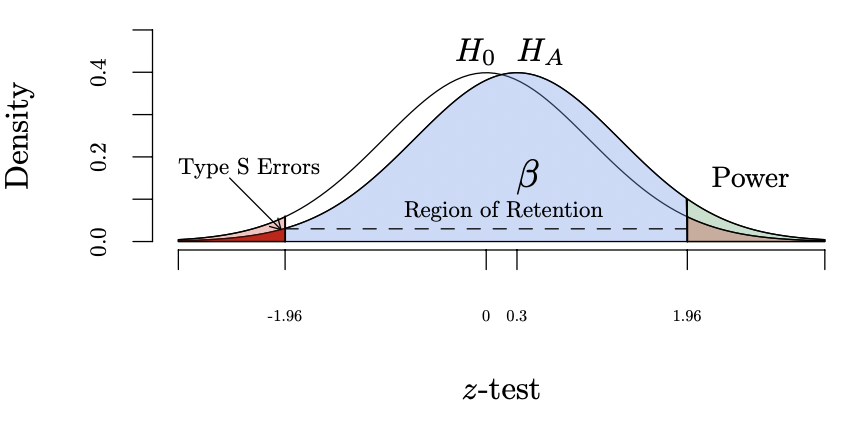
statistical power and inferential errors graphed
type I error = light red region on H0 distribution
type II error = blue part of HA distribution in region of retention
type s error = dark red region in HA distribution below -1.96
if i retain the null, what is the probability that i have made a Type I error?
0% - can’t make a type I error
if i reject the null, what is the probability that i made a Type I error?
0 or 1 - either didn’t or did make a Type I error
if i reject the null, what is the probability that I made a Type II error?
0% - can’t make a type II error
if the null is false in reality, what proportion of 1000 researchers examining this hypotheses with make a Type I error?
a (usually 5%)
sampling distribution
distribution of a statistic calculated from all possible distinct random samples of of same size n drawn from population
expected value
mean of sampling distribution
standard error
standard deviation of sampling distribution
central limit theorem (CLT)
know mean, standard deviation, form of sample distribution of sample means for the sample distribution of the sample mean when when it is not possible to take all possible samples
mean of sampling distribution of sample means
E(x̄) = μ (equal to population mean)
standard deviation of sample means
standard error of the mean (σx̄ ̄ = σ/√n)
n = sample size for mean
σ = standard deviation for population
direct route hypothesis testing
compute parameters of interest on entire population using descriptive statistics (never know parameters of entire population)
indirect route hypothesis testing
compute descriptive statistics on random sample from population and infer values of population parameters and draw conclusions
scientific hypothesis
relationship/effect researcher expects to find - restated into null and alt hypotheses for indirect testing (mutually exclusive and exhaustive together)
null hypothesis (H0)
involves a prediction about exact value of population parameter - assumed to be true
always contains an equity symbol ≤, ≥, or =
H0 :μ = 120, H0: μ ≤ 100, H0 : σ = 11, H0 : μ1 − μ2 = 0
alternative hypothesis (HA)
accepted if H0 is rejected
always contains and inequality symbol: <, >, or ̸=
HA :μ < 120, HA : σ ̸= 11
8 steps of hypothesis testing
state problem and nature of data (nature = nominal, ordinal, interval, ratio, censored, truncated)
specify and state hypothesis to be tested (scientific, null, alt)
draw random sample of size n from population (randomly selected and representative)
determine sampling distribution of statistic being calculated (mean, SE, form of null distribution)
specify level of significance
determine regions of retention and rejection
calculate value of statistic of interest
test hypothesis and reject the null if it falls in region of rejection or retain the null if it falls in region of retention
p-value
probability of observed data or more extreme under the null sampling distribution
doesn’t tell us the probability of the null (effect size)

test statistic
general formula simply number of standard errors from the null sampling distribution
based on theoretical sampling distribution of null
use common reference distributions (z, t, etc.) to determine probabilities of the data
θ is the population parameter of interest
estimated by statistic θˆ
E(θˆ| H0) is the expected mean of null sampling distribution for the statistic.
SEθ | H0 is standard error for the statistic when null is true.
central distributions
distribution of test statistic under the null of no effect
λ = 0 - all you require are central distributions
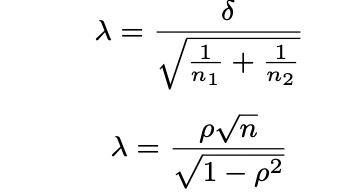
non-centrality parameter (λ)
measure of the degree to which a null hypothesis is false
forms confidence intervals for effect sizes
function of population effect size and sample size
probability function
used to obtain p-value - probability of a specific value and lower or higher
given the quantile, calculate the probability
quantile function
determine test statistic that has specified probability of occurring
given the probability, calculate the quantile
for two-tailed tests (normal and t-distributions), divide alpha by 2
critical values
quantiles on Ho distribution

normal distribution
population mean μ
variance σ2
Gauss’s 3 assumptions for normal distributions
small errors more likely than large errors
for any error ε, likelihood of ε is same as that of −ε
with several measurements containing independent errors, average has highest likelihood of producing observed data (max likelihood estimate of underlying parameter)
probability calculation for normal distribution
pnorm( )
calculate 2-tailed tests: 2 * pnorm( )
quantile calculation for normal distribution
qnorm( )

chi-square χ2(df)- distribution
sample distribution of sample variation - Function of squared normal distribution
each df represents another independent observation from normal distribution
sample variance is a function of since variance is a squared value when original observations are normally distributed
mean of sampling distribution is its df
probabilities for chi-squared distributions
pchisq(critical value, df, lower.tail)
all p-values inherently two-tailed (don’t divide a)
quantiles for chi-squared distributions
qchisq(alpha, df, lower.tail)
not divided by 2
degrees of freedom
finite sample size correction - account for variance in sample
assumptions of chi-squared distributions
residuals are independent: we have correct df - violating has huge impact on type I error
normally distributed: if violated, we don’t know distribution of sample variance
estimation of sample variation gets better as sample size increases

t-distribution (student’s t-test)
ratio of normal distribution and square root of chi-square distribution
statistic in denominator instead of a parameter
standard deviation is a function of sqrt(χ2(df))
probabilities for t-distribution
pt(critical value, df, lower.tail)
2x when wanting to find both tails
quantiles for t-distributions
qt(alpha, df, lower.tail)
divide alpha by 2

F-distribution
ratio of 2 variance estimates, ratio of χ2 (df ) variables
has 2 df associated with it
commonly used in context of ANOVA
always two-tailed
when df1 = 1, it is the square of t-distribution
when df2 = infinity, it is the chi-squared distribution/df
probabilities for F-distribution
pf(critical value, df1, df2, lower.tail)
quantiles for F-distribution
qf(a, df1, df2, lower.tail)
a not divided by 2
Which statistic has a lower p-value z = 2.0 t(16) = 2.0?
z = 2.0
which test statistics have the same p-values? z = 2.0, t(16) = 2.0, χ2(1) = 4.0 F(1,16) = 4.0?
t and F, z and χ2
why does pnorm(2.00, lower.tail=FALSE) not give us the p-value 4.0 but pchisq(4.0, df=1, lower.tail=FALSE) does?
is inherently two-tailed but normal distributions aren’t, so to get that value, you would have to multiply it by 2
for a = .05 under normal distribution, is critical value of 1.96 (a) a p-value, (b) a quantile, (c ) a parameter, or (d) a test-statistic?
quantile
what do df for a t-test indicate? does this tell us about the amount of info in the means or variance?
Inform us about amount of information (and thus precision) associated with estimate of variance that is being used incomputing the t-test
which statistic’s sampling distribution is the χ2(df)-distribution related to?
sampling distribution of the sample variance0
scatterplot
graph where each individual data is represented by a plot on the graph - use jitter and loess curve to improve its utility
jitter
small amounts of random noise in x or y-axis to avoid overplotting
loess curve
nonparametric smoother (doesn’t presume any relation between the variables)
control span (amount of smoothing) and fitting model (relationship you want to use to estimate relationship within each span)
simply estimates a relationship based on observed data
more properly approximated observed data
pearson product-moment correlation (r )
measure of linear association between two variables after removing units from each variable by standardizing them
common effect size measure
formula provides correlation for other methods
presumes linearity and independence, normality, homogeneity of variance
attenuated by restricting range on observed variables (reduces SD and reduces the magnitude)
based on t(df) distribution - df = n-2
spearmen correlation (rs)
association between ranks of two variables - replace each observed value for x and y with its rank
more robust to assumption of normality, but statistical power is reduced
useful for monotonic relationships (association is strictly increasing or decreasing)
point biserial correlation (rpb)
pearson correlation between a dichotomous variable (like treatment/control) and a continuous measure
just use Pearson to compute - for distinguishing one of the variable is dichotomous
based on t(df) distribution - df = n-2

φ correlation
measure of association between two dichotomous variables
done using Pearson r formula if data are numeric or using cell counts in a table
table: define each cell and then calculate - 2×2 table = A, B, C, D
dichotomous
a classification system that divides things into two mutually exclusive categories.

χ2(df)-test for independence
tests difference between what we expect to see under null of no association vs observed data
significant = rejection of null
function of observed count (O) and expected count (E) for cell i as follows where df = (#rows - 1)(#columns - 1)

distance correlation (dr)
measures dependence between x and y by computing distance of each observation from every other observation
addresses issues in Pearson correlation insensitive to deviations from linearity
0 to 1 (0 = complete independence, 1 = perfect dependence)
dcor.ttest(x, y) in R
probability under the null using a large number of random correlations - dcor.test(x, y, R=10000)
unbiased dr is smaller than r
do multiple studies in an article safeguard inferences?
No
under standard data-analytic and research practices make significant results easy to obtain (omitting variables of no significance)
familywise type I error rate
probability of at least 1 type I error being. made across set of tests in a manuscript

effect size
degree to which treatment changes the treated subjects relative to control subjects/degree to which phenomenon is or isn’t present in the population'
ratio of systematic variance relative to error or residual variance - signal-to-noise ratio

effect size: Cohen’s d
standardized mean difference - difference between treatment and control mean relative to standard deviation
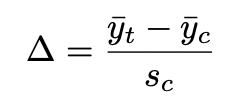
glass’ ∆
measure of effect size

Hedges’ g
unbiased estimate of standardized mean difference based on pooled standard deviation
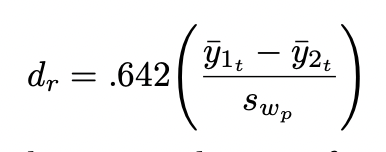
standardized mean difference for robust t-test (dr)
y1 and y2 = trimmed means from groups 1 and 2
swp = pooled Winsorized standard deviation (.642 adjustment for 20% of each tail)
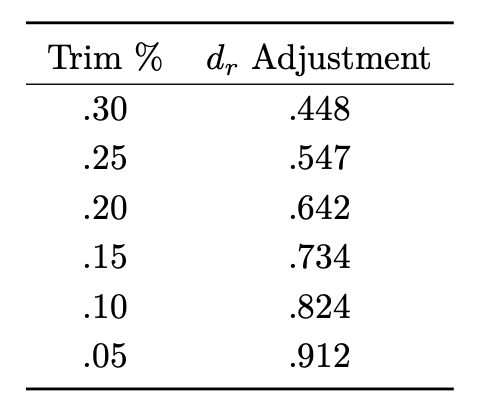
statistical power
probability of correctly rejecting a false null
function of sample size, alpha, and effect size
determining statistical power for one-sample z-test
Draw null hypothesis theoretical sampling distribution.
Calculate regions of retention and rejection.
Determine and draw alternative hypothesis theoretical sampling distribution on the same graph.
Calculate power as proportion of sample means in alternative hypothesis sampling distribution that is region of rejection.
determining statistical power for independent sample t-tests
same as z-test, except:
can’t express hypothesis distributions and regions in terms of specific scores as we don’t know population parameters
indicate ncp when calculating pt( ) (treatment mean - control mean / standard deviation
if effect size and alpha remain same, what happens to power when n increases?
it increases
if you decrease effect size, why does power decrease?
mean z-test under HA decreases as a result which reduces power
how are beta and power related
power = 1 - beta
if you increase alpha from .05 to .10, what happens to power?
it increases because increasing alpha also increases the region of rejection
For independent samples t-test, if effect size and α remain the same, and n increases, there are two reasons statistical power increases. What are these two reasons?
noncentrality parameter (mean of the alt distribution on the t-test scale) increases.
critical t-value decreases, which increases region of rejection
confidence interval
index of uncertainty associated with a statistic (usually 95% for alpha = .05)
calculated by hand once critical t-values are determined
tcrit tells how far estimates are from true population through number of standard errors from 0
intervals will cover population mean difference in 95% of random samples
confidence intervals for single means
one sample size

standard error of the mean (sy ̄)
standard deviation / sqrt(n)
confidence interval for mean differences
2 sample sizes and 2 means

sy1 - y2
estimated standard error of difference between 2 means

spooled
pooled standard deviation between 2 means
sqrt((var1² + var2²)/2)x

p-value for difference between two means
differences between sample variances - null hypothesis / SE between means
μt − μc = null (often = 0)

calculating CIs for standardized effect size estimates
function of population parameter and where it intersects with observed statistic
not calculable unless we assume normality and homogeneity for errors, so resampling approximates these CIs
values of that have cumulative probabilities between .975 and .025